“Lesson one. You’re old. Accept that.”
I don’t like the Cars franchise.
Especially the film part of it.
There, I said it.
What started out as a vaguely creepy and not really all that well thought out if genuinely good looking film about anthropomorphic cars turned into a yeah still creepy and not all that well thought out if genuinely beautiful film about spy cars in its second installment and, in its third installment, into a seriously creepy and definitely not all that well thought out if spectacularly beautiful film about anthropomorphic cars turning old and getting slammed with clinical depression and look, gorgeous, color drenched images of U.S. landscapes can only do so much.
And that so much is just not enough.
Is Cars 3 a technically better film than the first two Cars flicks, not to mention one that honestly tries to engage with a couple of the major issues from those films? Sure! Does Cars 3 offer an astonishing range of different racetracks from dirt to high tech, apparently inspired by various NASCAR tracks around the country and a few tracks no longer in use? Also sure!
I still hated this film.
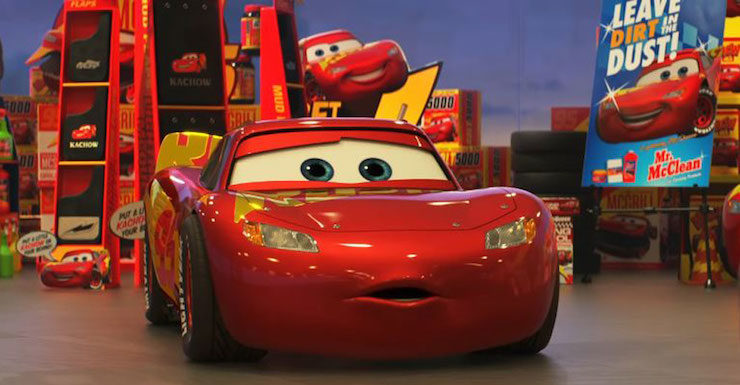
Back in 2011, Pixar and Disney were not overly concerned with my feelings about anthropomorphic cars. Cars 2 had just been released to the grudging praise of “Well, it could have been worse,” a box office take somewhat higher than the one from the original film, and—most importantly, from Disney’s viewpoint—outstanding merchandise sales. Indeed, from 2006—2011, the Cars franchise had grossed about $10 billion from merchandise sales alone, making it one of Disney’s most lucrative franchises—if one still trailing behind Winnie the Pooh and Disney Princesses. Plus, Toy Story 3 had done quite well at the box office and with selling Buzz Lightyear toys. A third Cars film was definitely in order.
And although no one exactly had a plot or idea in mind, they did have one major advantage: RIS, a new rendering system tested out on Finding Dory, which allowed animators to animate and shade and darken scenes all at once—giving a near immediate sense of the final product. For audiences, RenderMan RIS had a different advantage: richer, deeper colors for background images, and carefully shaded individual blades of grass that shifted in color from scene to scene and time to time. It also helped give the speeding cars a blurred look, imitating that video effect, and adding realism to a film with a basis less and less realistic every time I think about it.
RenderMan RIS didn’t quite eliminate all of the technical challenges. For a film ostensibly about the arrival of news higher tech cars, Cars 3 has a lot of mud, and I do mean a lot of it, mostly in a demolition derby scene but also in other, quieter moments. As it turns out, animating moving mud and making it look nearly photorealistic is not quite as easy to do as it is to type. The problem, at least according to animators, is that mud is something between liquid and solid, creating lighting issues, movement issues, and other assorted issues. For this, Pixar needed a different program—Houdini.
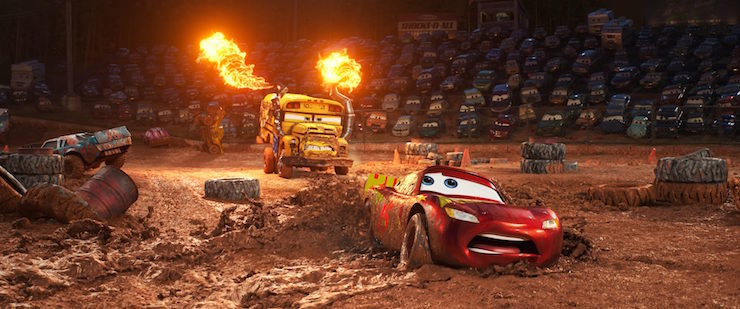
All of this, and Disney’s insistence that Pixar release both 2D and 3D editions of the film, meant that the animation and rendering process took more time than it had for Cars, instead of less—even with what Pixar termed “farms” of computers working on the film. Somewhat fortunately, they found themselves slightly helped out by the development problems with The Good Dinosaur, which pushed Finding Dory back a few months, allowing Cars 3 to be released in 2017, and giving the animators slightly more time.
The development issues with The Good Dinosaur also sent Bob Peterson back to work on the Cars 3 screenplay, along with Kiel Murray and Mike Rich. The film was directed by Brian Fee, who previously had worked as a storyboard artist and animator on a number of Pixar films. Most of the original voice actors from Cars were brought back to reprise their roles, with a few exceptions: Bob Peterson took over for Michael Keaton, busy with other commitments, and Lloyd Sherr took over for the minor role of Fillmore, previously voiced by George Carlin, who had died in 2008. Rather than to have anyone attempt to reproduce Paul Newman’s unmistakable tones, Pixar used archival recordings of unused dialogue from the first Cars film, thanking the actor’s estate in the credits and giving Newman a posthumous acting credit. Cars 3 also brought in comedian Cristela Alonzo to voice new character, racing car trainer Cruz, Chris Cooper as new mentor character Smokey, and renowned character actress Margo Martindale as Louise “Barnstormer” Nash, who has fond memories of car racing in the old days, as well as various celebrities voicing minor cameo roles.
Two of these characters also helped to address a concern noted by both critics and Disney executives: the problem that throughout two straight films, the race cars had all been voiced by men. Cars had featured a few cars voiced by women, as well as an attorney car who doubled as Lightning’s love interest, and Cars 2 had a spy car voiced by a woman, but the race cars? Men. This was partly because when Cars was made, many famous race car drivers—not incidentally the ones that Pixar pulled in for cameo voice roles—happened to be men, and partly mitigated by the presence of spy car Holley Shiftwell in the second film. And also partly because Pixar films up until Brave (created after Disney’s purchase of Pixar had tended to focus on male protagonists, to the point where even now, only three of the nineteen Pixar films—Brave, Inside Out, and Finding Dory – center on girls. A third Cars movie could, Disney felt, somewhat address that problem by bringing in a girl car. Or maybe three, if they added in a long retired car and maybe—just maybe—a demolition derby truck car, both voiced by women.
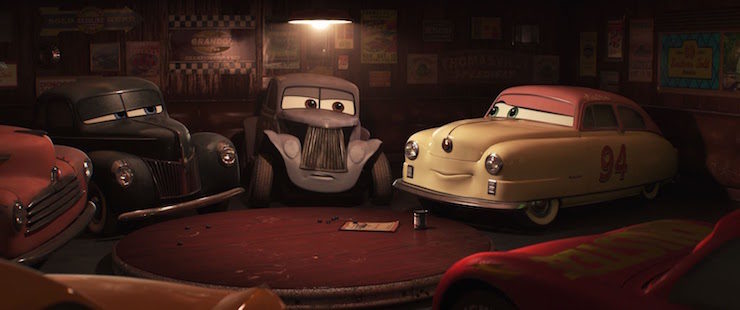
The demolition derby truck turned out to have too small of a role in the film to make much of an impact one way or another—though the truck was able to show off Pixar’s new mastery of animated mud. But Louise “Barnstormer” Nash (loosely inspired by real life NASCAR driver Louise Smith), somewhat clumsily tackled the all men race car issue by explaining that when she first showed up to race, the other cars didn’t like the idea of a “lady racer” so they wouldn’t let her have a number. So she stole one. Heh.
And racing car trainer Cruz—well. Her role is a bit more questionable, as we’ll see.
Cars 3 starts off by briefly reminding us of the various characters—racing car Lightning McQueen; his now apparently dead mentor Doc Hudson (among the many problems here: Cars is extremely vague about how, exactly, sentient cars can “die” given that (a) they can be and are repaired throughout this film and (b) a Model-T, presumably created sometime before 1927, is still rolling around); Mater, still as annoying as ever; Sally Carrera, serving mostly as a barely seen cheerleader and occasional attorney (mostly making me wonder: do sentient cars get married and have little cars? See, Cars 3, this is the sort of thing you’ve avoided explaining for three films now and it’s really starting to bug me); and the rest of the Radiator Springs crowd, with only Luigi and Guido playing any sort of ongoing role.
All seems well at first, as Lightning jokes with his fellow race cars—until, gasp, Lightning loses a race, to a younger car with more advanced tech. The racing season gets worse and worse, until Lightning tries to win with one desperate move –
— and crashes.
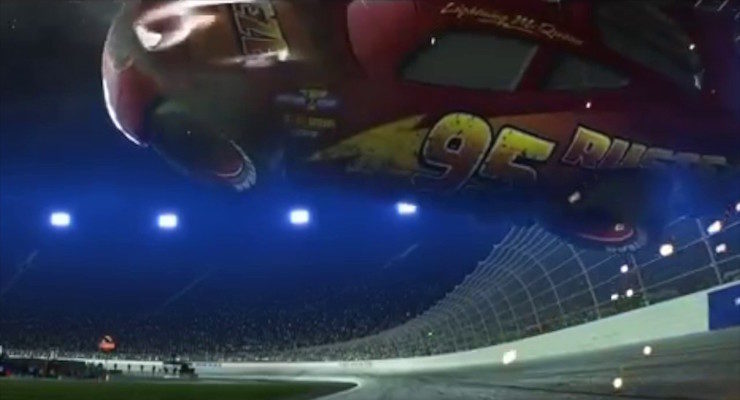
The crash scene appeared in several Cars 3 trailers and reduced at least some small kids, more fond of Lightning than I am, to tears. In the film, it’s pretty much immediately followed by a scene showing that Lightning is alive and well physically, if very depressed mentally, somewhat limiting its impact—as do later scenes suggesting that Lightning is more traumatized by losing than by the presumably painful memories of the car crash. (I know, sentient cars, but several of the cars complain about various aches and pains, and in Cars 2, a spy car was tortured, so, yes, they can feel pain.) Lightning mopes for some time before Sally Carrera comes in to offer some motivational words before vanishing for most of the rest of the film. It says something about their relationship, and not a great something, that Lightning later gets updates on how she’s doing from Mater, but let’s move on. Lightning decides to start training to race again, determined to beat new rival Jackson Storm.
To do so, he needs to train, so he heads up to Rust-eze’s new state of the art training center—now under the new ownership of big racing fan Nathan Fillion. (Pixar would doubtless like to interrupt me here to point out that Nathan Fillion has a name in the film, but the name doesn’t matter: it’s Nathan Fillion.) Here he starts training under the enthusiastic guidance of trainer Cruz—one of those girl cars that Disney hoped would sell more toys.
And here’s where things really start to go wrong with the film. Oh, not with the toys. Disney was spot on about that. The Lightning McQueen/Cruz Ramirez twin sets were instant toy hits, and Cruz independently sold plenty of little yellow cars. And not with the art—Lightning’s trip up to the Pacific Northwest looks stunning, a model of just what can be achieved in computer art. No, the rest of the film.
Up until this point, Cars 3 had just been, well, depressing, a film mostly about getting old and shoved out of the way in favor of younger, more energetic and tech friendly models—a rather encouraging note for younger viewers, now that I think about it, if perhaps a little less comfortable for their elders, especially their grandparents. As the training starts, however, Cars 3 moves from being just depressing, to being mildly freaky and inconsistent.
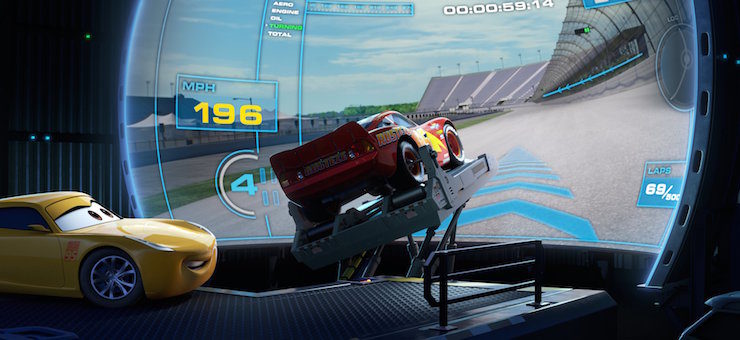
This is partly thanks to the images of cars running on treadmills and having their trainers blow bugs into their faces er windshield which, mildly creepy, and also, didn’t the first Cars movie sorta imply that all of the bugs had been changed into Volkswagen Bugs, in which case, even more creepy. And it moves on to Nathan Fillion starting off Lightning’s training by cheerfully saying “But first, let’s get you into a more contemporary look,” and by “more contemporary look,” what Fillion MEANS is that Lightning is going to be heated up and have his sides squeezed in and we do know how hot things need to be in order to GENTLY shape car metal and not just, well, dent it, and this is all happening to a SENTIENT CAR and have I mentioned just how disturbing the Cars films can be if you try to think about them?
This is all to put an electronic suit on Lightning so he can be precisely tracked right down to his vital signs WHICH IS NOT REALLY ANY LESS CREEPY if you think about it and maybe I should stop trying, but I’m only part of the way through this film. Let’s keep going.
Then there’s the trainer, Cruz, who says things like, “You can use anything negative as fuel to push through to the positive,” which, yuck, but again, we’re only part way through the film, so, let’s move on. She’s supposedly gifted at training and motivating race cars, and yet, she starts out by making a number of incredibly tactless comments to Lightning about his age. It’s awful to watch. And inexplicable—not just because she’s a motivational trainer but because, as Cars 3 later reveals, when Cruz was a little car (let’s try not to think about this) she watched all of Lightning’s races and dreamed of becoming a race car just like him. Frankly, her earlier comments make that later revelation ring a little hollow.
She later says that she looks different than the other racers and lacks their confidence, thus why she left her first race she dared enter—but this story, too, doesn’t match with her earlier scenes of brash self-confidence and conviction that she’s correct. And as far as appearances go—multiple scenes show us ever evolving racing car shapes, and also, cars actually changing their shapes and colors and adding details that allow them to turn into race cars. It’s meant to make us sympathize with her—and also reinforce Disney’s ongoing “never judge by appearances” message—but it falls flat. I mean, sure, it’s possible that she’s put on that veneer of brash self-confidence to hide her inner anxieties, but if so, that’s not something that really comes across in the film.
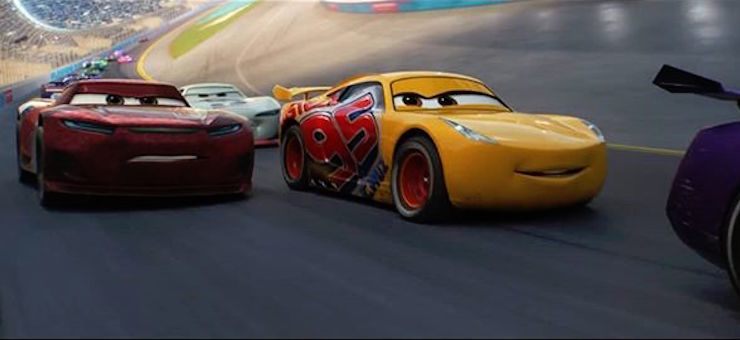
And that “never judge by appearances” message is further undercut by the ending, where yes, the race car that never thought she could even enter another race, much less win one, finally wins—but most of that race was run by another car, Lightning, making this a shared win. Could she have won the race had she started with the other cars at the beginning? Maybe—maybe not. It’s not just a long, endurance race; it’s an intelligence race, with pretty much every race car agreeing that Lightning might not be the fastest—but he can be the smartest. Could Cruz have matched that intelligence? It’s not clear.
Buy the Book


Worlds Seen in Passing: Ten Years of Tor.com Short Fiction
There are other odd bits—for instance, the way the major car race in Florida is not at NASCAR hot spots Daytona or Homestead, but Miami Beach, and, while we’re at it, the way the beaches in Miami—Miami—seem completely deserted. I mean, yes, I get that these are sentient tourist cars, not sentient tourist humans looking for some sun, but it still feels totally wrong. And also, what happened to the bridges, and how exactly do condos work with sentient cars, and…and…I need to stop asking these questions, don’t I? Or the moment when Nathan Fillion comes and rather than giving Cruz the dressing down she absolutely deserves for disappearing from his high tech training center, not warning him that the car he intends to use as a major marketing brand is about to make a major PR mistake, and then vanishing for days, instead orders her to leave in the middle of a race to go start training another car. At this point, Lightning is actually doing pretty well in the race—not winning, but with a solid chance of placing in the top ten, and there’s no reason why Cruz can’t wait around for another few hours to watch the end. But no—Nathan Fillion orders her to return to the other side of the country, and then adds a few gratuitous insults about her appearance, pointing out that she’s not a racer, she’s a trainer.
It’s all to set up the final twist, but it’s a setup that doesn’t make any sense—not to mention that up until this point, the film has made a big point of noting that the most successful trainers were all former race cars, thus, Cruz actually racing a race or two would turn her into a better trainer, something Nathan Fillion needs.
So, Cruz, a character brought into the film in part to increase the franchise’s girl power, ends up spending most of the film doubting her own racing abilities, and wins only by finishing someone else’s race. I guess this is mildly better than the general lack of girl power in Cars and Cars 2, but not by that much.
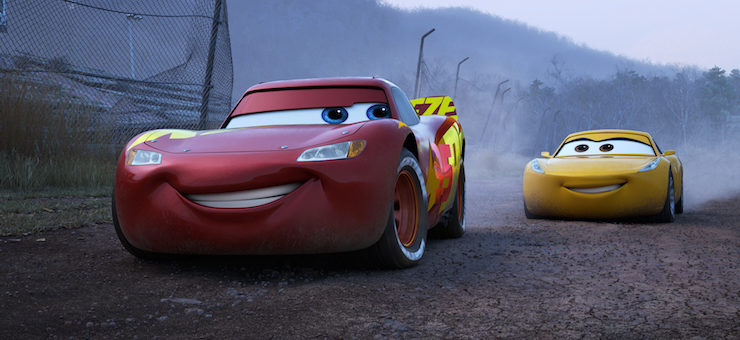
I’m also not at all clear on why, exactly, Lightning feels so old and beyond racing. Oh, sure, new high tech cars, but Cars came out in 2006—not all that long ago, and certainly not all that long before this film’s 2017 release. Admittedly, car racing, not my thing, so I had to look this up, but as it turns out, yes, many NASCAR drivers have enjoyed careers lasting more than ten years—including some drivers voicing roles in this film. I realize that real life cars frequently start breaking down after ten years (if not sooner) but surely anthropomorphic cars can and do last quite a bit longer—especially given all of the many sentient mechanic cars driving around, not to mention that at some point, the sentient cars have developed precision engineering. Something that race car Lightning presumably should have had back in 2006 (and seemed to). Also, is this precision engineering only available for shiny new cars and race cars? That seems mean.
It’s not that the film doesn’t have its lovely touches. As said, it looks fabulous—the background work here ranks as some of the loveliest stuff that Pixar has ever created, which is saying something. It includes several nice nods to the first film, from the cameo appearances of earlier characters to Lightning’s protégé finally earning the Dinoco sponsorship that a younger McQueen had once longed for. And if I continue to question just about everything about the lives of sentient cars as portrayed in this franchise—well. I can’t help but like the message here about how life doesn’t have to end just because one part of it changes.
Cars 3 earned $384 million at the box office—enough to cover its reported budget of about $175 million plus marketing costs, if considerably less than the $462.2 million earned by Cars and $562.1 million earned by Cars 2. Still, as with the earlier Cars films, the chief money was in the merchandising, with Cars toys, clothing, furniture and other assorted items still highly popular with kids—even if Lightning McQueen had gotten old. Critics, too, were kinder to Cars 3 than they had been to Cars 2.

It was enough, in any case, to allow Owen Wilson to announce that yes, Pixar was tossing around ideas for a, sigh, Cars 4.
I can only hope that Mr. Wilson is wrong about this.
Meanwhile, Pixar had something a bit more ambitious for their next film.
Coco, coming up next month.
Mari Ness lives in central Florida.










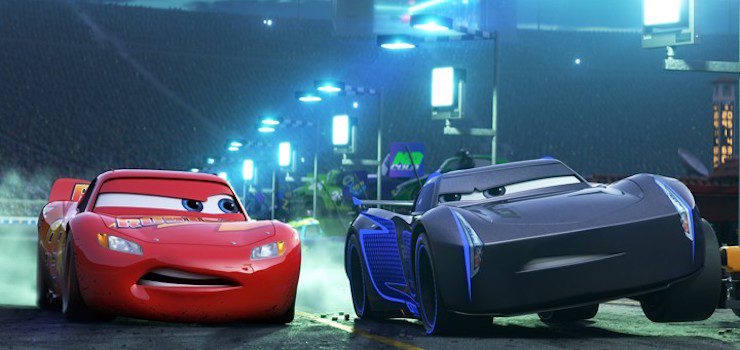
Holy hell am I glad my kids have aged out of the Cars demographic and moved on to slightly more sensible fare like Pokemon.
My biggest beef with the Cars universe: in world utterly devoid of animal life, WHY THE HELL DO THEY STILL HAVE FARMS?
#1 I can think of two reasons offhand: bio-fuels and rubber trees. ;-)
My current theory is that the Cars films are a distant, distant sequel to Maximum Overdrive, set in a world where the humans lost.
My five-year-old loved Cars when it came out, and their sixth birthday party remains the only one thematically tied to a particular movie. Of course we had to get the DVD and watch all the special features.
Before I had other reasons to feel queasy about John Lasseter, I was outraged by how his naive nostalgia blinded him to the destructive message sent by a gorgeous depiction of a world (recognizably our world) filled with cars and no people. Cars exist to serve our needs and our conveniences, and without this purpose they are pointless. The world of Cars is an ontological error, and it sentimentalizes the imposition of an environmentally-degrading infrastructure for no explained reason.
I understand why Lasseter would like to preserve Route 66 for his memory-building with his family, but I would have liked some acknowledgement of the cost to all of us for indulging it. I loved all the clever jokes and voice-acting as much as the next parent, but none of it could dull the ache of knowing the next generation is going to inherit a planet melted by the heedless use of these machines.
WALL·E somewhat redeemed Pixar on this score, but their addiction to easy sequels and merchandising is depressing. And yes, we later donated our share of non-degradable plastic licensed merch, for which we retain a debt.
Personally, I thought it was fine. I only saw this movie for the first time last week, as preparation for this rewatch. I figured Lightning would win his last race (or place respectably), credit Cruz for her help, then retire gracefully and become her coach, thus paying forward the debt he owed to Doc, and setting Cruz up to be the protagonist for future movies. While I don’t think the world needs a Cars 4, if she’s the lead character (and there’s even less Mater) then I can get behind that.
I will say that – flaws aside – as a middle-aged professional recently realizing that his skills may be better suited to leading and teaching than keeping up with the latest developments, Cars 3 hit home surprisingly hard for me.
Could you take a children’s movie anymore seriously?? Since when does the universe in which a story takes place need to be explained for overthinking adults in order for children to enjoy a good story and great animation?? Like seriously. Explaining every little detail in the movie would make it way too boring for it’s target audience. Why would it, for example, be relevant to the story that we know whether or not the cars reproduce like is, like plants or like in that robot movie starring Robin Williams several years ago? It would be extremely tedious, time consuming and a waste of money. If they made the movie to your liking it would be like making a LOTR movie where they include EVERY detail of the book in it. And if you’ve read any of the books, like I have, you would know that would have made the movies probably 5 hours long, and no one would want to watch it because are all the little details REALLY relevant to advancing the story?? Ummmmm, no. No it wouldn’t. I found many of the small details of the books to be just filler to make the book longer. Same applies with the Cars movie. Needless detail makes the movie move at a sluggish pace and causes the target audience to losel interest. The point of movies is to entertain! Not to answer EVERY single question you could possibly have about the universe.
And the reality that most NASCAR drivers ARE male, so most of the characters in the movie ARE ALSO MALE, obviously geared more towards BOYS, shouldn’t even matter. THAT part was realistic, but you have to find fault with that, too, huh?
My son loves Cars. It tells a great story, it entertains him and he is the target audience, AND it’s age appropriate. What else really matters??
In speculative fiction, there’s the principle of willing suspension of disbelief, emphasis on the “willing” — and some people simply aren’t buying what the “World of Cars” worldbuilding is selling. Or — does this actually qualify as speculative fiction, or merely a fable? One in which the actors in the morality play are motor vehicles rather than barnyard animals. If the latter, then plausibility is beside the point.
(I’ve said it before, and I’ll say it again: in my headcanon, it’s a world of victorious Daleks that reinstalled emotion, got bored, and embarked on a multi-decadal RPG based on one of their most ardent foes; with cosplay. That’s right, they’re swapped pepper-pot minitanks for cars, boats, planes and trains.)
Re: the potential Cars 4 — periodically, Pixar will say “we’re tired of sequels and would really prefer to concentrate on original stories” (possibly they like to contrast themselves with Dreamworks — four Shrek movies, four Madagascar, three Panda, soon-to-be three Dragons, and TV series for all of them) but it seems like somebody always arrives with a persuasive $$$ argument.
I agree, I just do not understand this type of movie. Then again, I never got Thomas the Tank Engine nor Jimbo and the Jet-Set either. It is just too nonsensical for even me, and I’m always at home for a bit of nonsense. There are just so many differences from what we laughingly call “reality” (a concept that continues to disintegrate beneath us) that there are no consequences to anything. Reality is so bent already that any and all twists are just robbed of meaning. We’re into “sure, why not” territory.
@8 Less about persuasive cash and more they have more contractual obligations for movies than they have actual original ideas, that is how I’ve always seen it. Not to sleight them (too much) because coming up with ideas is hard, and ideas which can be developed into a coherent story which hits the demographic is harder still, but it is very easy to then just say sequel based on something that already hit all that. That is my theory, that I just pulled straight out of my ass with no proof, anyway.
Just a reminder to please keep the discussion civil and constructive in tone, even if you disagree with the article or other commenters; you can find our full Community Guidelines here.
Tex Avery did a pair of old ‘toons for MGM, “Little Johnny Jet” and “One Cab’s Family”, that featured sentient planes & cars, respectively. Both were basically about baby planes/cars growing up. Logically, they were both as problematic with how the world worked as the Cars franchise.
“have I mentioned just how disturbing the Cars films can be if you try to think about them?”
“I need to stop asking these questions, don’t I?”
The force is strong with you – trust your instincts.
Or to put it another way – you don’t have to keep watching a film you aren’t enjoying. Nor do you have to keep thinking about it afterward, unless you are getting paid…ooooooh.
Cars cured my depression. Doesn’t matter that it doesn’t make sense. Still a great movie franchise except for Cars 2.
I thought everyone knew that Cars is the post-human far future of the Terminator universe.
I thought the first Cars movie was just okay, had no time for the second, and I keep forgetting there’s a third now. This does seem to be largely a world-building critique rather than a movie critique, where the world-building isn’t all that important to the success of the story. But reading between the lines, I think this is telling me there’s not enough here to redeem the trilogy as quality entertainment to stand alongside Pixar’s other efforts. Unless you’re five.
@12/BonHed: I’ve always assumed those Tex Avery cartoons were the direct inspiration for the Cars films. I do find it odd that so many people have trouble accepting the deliberately unrealistic fantasy of anthropomorphic cars; how is it any stranger than the anthropomorphic mice and ducks and dogs of the classic Disney shorts and the Carl Barks comics? I mean, there are actual cartoons of Donald Duck hunting non-anthropomorphic ducks with designs to kill and eat them. Goofy has owned a pet dog. These don’t make sense, but they’re not supposed to. The characters are treated as human regardless of their appearance, aside from a few comedic variations like giving them animal-pun names. And the difference can’t be because Cars is long-form rather than a short cartoon, because something like Carl Barks’s Duckburg reality has been sustained over decades of comics and several TV series.
Is it perhaps because the photorealistic animation makes it harder to see as a stylized cartoon? Or is it because the stories themselves get too close to the questions that are best not thought about for a concept like this to work? Or is it because it’s a greater conceptual leap to see inanimate objects like cars taking the place of humans in an otherwise humanlike world than it is to see other animals like ducks and mice in our place?
Or maybe it’s simpler than that. In the Tex Avery shorts, the incongruity and nonsensicality of machines being anthropomorphized was the point of the joke. Avery’s humor was all about embracing the absurd and the impossible. But when you make that absurdity the backdrop for telling a story about something else, something that tries to be less absurdist and tell an actual story that hangs together, then maybe the absurdity becomes a distraction rather than the gag in itself.
The vitriol towards this franchise still astounds me. I understand it not being somebody’s cup of tea – but I don’t know why this particular franchise is any less realistic than any of the other franchises. I don’t even drive, due to awful anxiety and just being a flat out bad driver. Racing is not anything I’m even remotely interested in. Cars (real life cars) are boring to me. But I still understand that, like toys, people can be very attached to their cars and almost personify them. So this seems like a very natural extension of that for those that are interested in such things. It’s a metaphor. And as I do love road trips, I can appreciate that.
Anyway, I love the first movie and the general message it has, and the second is okay. I enjoyed this one quite a bit as well – the story of somebody coming to terms with the passage of time and growing older and identity is interesting to me. All that said I agree with your general plot criticisms – Sally is always underused, and I never quite ‘got’ the way the shared race worked or why that would be allowed. But overall I enjoyed it and so did my kids. I can’t say I’m chomping at the bit for Cars 4 (the story is fairly well told by now).
@20/ChristopherLBennett, I do love me some Tex Avery. I loved his absurdity, and the frenetic pace at which his ‘toons ran. And I really loved these two stories he made. They must have been high on the list at Pixar for inspiration for Cars. They worked fine as the shorts, but I think the longer running time of Cars gave more opportunity to scrutinize the logistical issues.
Anthro animals seem to work better because they at least have recognizable features such as arms, legs, paws, which makes it easier to rationalize how they could function as humans. The bit where they do break down is exactly where you state, with the non-anthro animals.
Sentient machines like planes and cars… they don’t have anything quite right for arms and legs or hands. It challenges the verisimilitude and suspension of disbelief much more to rationalize tires being hands.
Avery did it much more silly and fun, while Cars went more for realism, which makes the logistical issues much more prevalent.
@22/BonHed: And yet My Little Pony: Friendship is Magic gets away with anthropomorphic equines who build technology and wear clothes and the like despite having no manipulative digits (and only some have telekinesis).
@23/ChristoperLBennett re: MLP:FIM’s lack of hands — well, it seems the pedal extremities (*) of the Equestrian species can function as dextrous gripping appendages, in conjunction with the more-flexible-than-equine articulation of the shoulders and elbows. Maybe they’re adhesive? There’s a joke about this in a fan webfilm (expanding upon the joke background character of “Doctor Whooves”) in which The Doctor arrives, regenerates into a pony, and fumbles his sonic screwdriver.
(*) We’d call them “hooves” if they were Terran equines, but they’re certainly not drawn as hooves, FWIW. Okay, now I’m thinking about a photorealistic treatment by Wayne Barlow with an inset of a horny, segmented surface equally suited to galloping and gripping.
I’m reminded of a line from Star Trek: Prime Directive (Reeves-Stevens, 1991) in which a Tellarite wonders how humans get by — “they might as well have seaweed fronds.” And a line from The LEGO Movie (2014) in which Emmet has a vision of “the man upstairs” and his five-fingered hand, so very unlike a minifig’s clamp.
Personally, I’m more bothered by all the Pony-built household furniture which is suited to a bipedal, upright posture, as contrasted with the segments of the Well World books (Chalker) featuring centaurs and their furniture, which had a little more worldbuilding thought.
“[…] do sentient cars get married and have little cars?” – Of course. Where do you think toy cars come from?
I imagine that cars are marsupials. That’s why they have trunks.
Please remember that for some reason autistic kids love Cars. My boy has almost everything that you can but from the series and it really helped him connect to others via play and increase his verbal skills. We spend hours each week playing with his stuff and creating new stories based on them. We took him to the California Adventure Park and when he walked into Radiator Springs he was the happiest kid in the world. Is he obsessive, of course he is, but the joy and help that Cars has given him is priceless.
Thanks Pixar, you have helped many kids and families.
@20: I’d say the difference between Duckburg and the Cars universe is that Duckburg embraces its own absurdity. It’s a recent example, but I’d point to the way that the new DuckTales pilot literally starts with tracking shots of non-sentient seagulls before homing in on the totally anthropomorphic Donald, and then bases its plot on Glomgold’s obsession with being the world’s second richest duck–not person, duck, despite there being ample plot setup just in the one episode that there are plenty of other species doing business–as strong examples of leaning into the absurdism. I don’t get that feeling from Cars. I find it pretty humorless, and ultimately boring.
I don’t agree that an animated film can’t have effective worldbuilding. It can’t do worldbuilding in the same way that a novel does. It has to be very suggestive and do the work with visual cues and carefully written throwaway bits of dialogue. But just within Pixar, contrast the very effective worldbuilding that sets up the rules of the Toy Story world with the lack thereof in the Cars world. Or, indeed, if you want to stick with anthropomorphic machines, contrast Lasseter’s own work on The Brave Little Toaster, which leans into the creepy and makes it work as part of an affecting story way more than any of the Cars movies.
“I imagine that cars are marsupials. That’s why they have trunks.” Gah! uhr…Jou.. AAHHHHRG!!
About a year ago some friends and me were discussing this very topic for a while. And I feel that we came up with a good reason for the issues with the realities of these films. Anthropomorphic vehicles in other shows use cartoon logic. The Tex Avery example showed the plane family moving and acting just like people, but they were planes. They could twist their body around and move in fantastic ways. Remember when Benny the Cab ran across Dip, he was in pain and had to drag himself around on damaged wheels/feet. But in Cars logic, where the premise is a cartoon (sapient cars), they otherwise stick to reality. Kind of.
When McQueen loses a tire, a mechanic (not a doctor) pops off the wheel and puts on another. They are demonstrably shown to be machines. Alive yes, but still machines. They have engines, need 10W40 and probably use windshield wiper fluid. Now this IS fascinating, but it invites questions that normal cartoon logic would not. In cartoon logic, the extremes are the normal. You can swing an anvil into someone, smooshing their head against a wall. And that is worthy of a sigh. In cars damage needs to be buffed out. It’s assumed that maintaining traction on the race track matters.
But all that aside, I rather enjoyed speculating what was going on while watching. I can suspended my disbelief to enjoy a show about anthropomorphic cars. For me what threw me out of the movie was a throwaway gag. The bugs. The Volkswagen bugs. Up until then I could see cars as the new world order, but now they replace ALL life? I can’t remember, were their any birds in the desert? Was it a Ford Falcon? I know it was just a quick gag, and a funny one at that, but this REALLY is where I have issues.
But still fun. I particularly liked having Click and Clack in there. We miss you “Ray” Magliozzi.
Actually, there is one point in particular that knocks me out of the Toy Story world, and that is The Rule. Not letting people see toys are alive. At first I kind of thought it was involuntary, but then Woody and the damaged toys break it pretty thoroughly in the first movie. Thing is, they’ve established this all-important rule and then immediately introduce a character incapable of obeying it because he doesn’t believe he is a toy! That’s why I thought it might be involuntary, because why else would Buzz freeze when people are around and he’s in the open? He gets lucky a few times, but he does freeze when in the full view of people for what to him would be no reason.
As to Cars, I never have liked anthropomorphic inanimate objects. I sort of go along with it in 1920’s and early 30’s cartoons because absolutely everything appears to be alive in most of them. I didn’t like either of the car cartoons by Tex Avery, though I love his work and the sheer insanity of his MGM cartoons especially. In Cars, with its elaborate car world, I do get to wondering who is building everything. If they showed that robotics were a part of this world it would help a lot. Like robotic auto manufacturing lines, except grown more detailed, perhaps with hand-like appendages to build anything the cars want or need?
I do think it gets a bit harder to suspend my disbelief with the increasing photorealism of CGI. Zootopia is beautiful to look at and they actually do try to make a city that isn’t just a human city, but because they chose to use ALL animals you do really end up wondering what the Preds are eating to get their proteins. Glossing over some questions doesn’t work if you are aiming for an all-age audience, not just kids.
@31/Lisa: Weren’t the animals in Zootopia pretty much all mammals? I got the impression that birds and fish and the like were still animal-animals rather than animal-people.
On the disc extras they talk like while mammals were what they used in this city, other animals such as birds could live elsewhere. It’s really not a good idea. Why would Preds choose to stop hunting Prey if they’re going to starve or be malnourished as a result? Kimba tried to solve that problem in his peaceful jungle, but I’m not sure if eating insects was the answer for him, either. I’m glad Tezuka addressed the issue, though. He even had rebellious big cats that were sick of eating insects.